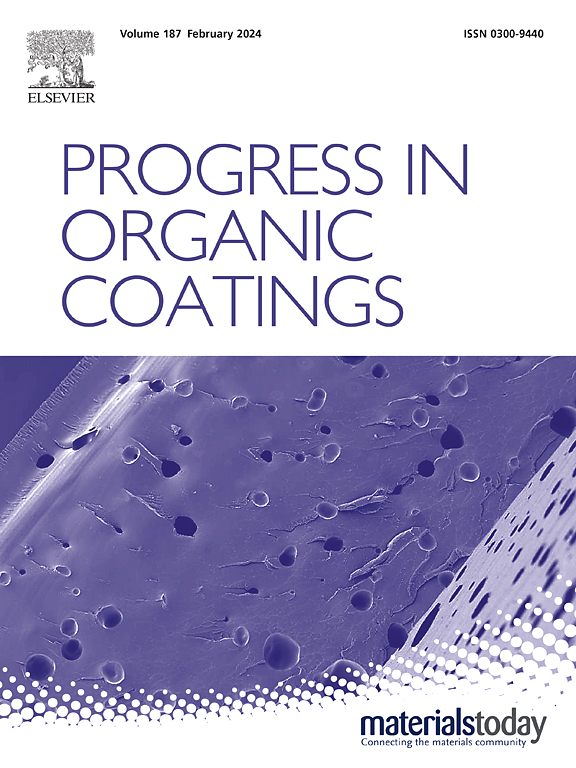Preparation of mechanically robust, self-healing superhydrophobic coatings based on novel fluorinated polyurethane via a “two-step” polycondensation process for applications in self-cleaning and anti-icing
IF 6.5
2区 材料科学
Q1 CHEMISTRY, APPLIED
引用次数: 0
Abstract
The demand for superhydrophobic coatings has been rapidly increasing, extending from applications in surface antifouling to surface anti-icing and self-cleaning, driving active exploration into mechanically robust superhydrophobic coatings. Fluorinated polyurethane (FPU) is considered a promising candidate for superhydrophobic coatings. However, most FPU-based superhydrophobic coatings exhibit limited adhesion to substrates and rely on nano-SiO₂ or nanoparticles to construct micro-nano hierarchical rough surfaces. However, it has been demonstrated that the rough surfaces created by nanoparticles reduce the effective contact area between the coating and the substrate, leading to accelerated wear of the coatings. Furthermore, to ensure the durability of superhydrophobic coatings, self-healing properties must also be considered. However, most self-healing superhydrophobic coatings developed so far require prolonged high-temperature conditions or external stimuli to restore their superhydrophobicity. Therefore, developing mechanically robust superhydrophobic coatings with self-healing capabilities remains a significant challenge. In this study, we synthesized a novel fully waterborne and self-healing FPU coating using a “two-step” polycondensation method. Even on the smoothest and hardest glass substrates, the coating retained its superhydrophobicity after 200 cycles of sandpaper abrasion, 200 cycles of tape peeling, a 6-hour water droplet test and acid-base resistance tests, outperforming most previously developed superhydrophobic coatings. Additionally, the coating exhibits excellent self-healing functionality. This allowed the coating to self-heal a 100 μm scratch and restore its superhydrophobicity within 56 min at room temperature without any external stimuli. The coating also exhibited excellent self-cleaning and delayed ice formation properties. This novel design and fabrication strategy provides a new perspective for surface protection.
采用“两步”缩聚工艺制备基于新型氟化聚氨酯的机械坚固、自修复超疏水涂层,用于自清洁和防冰
对超疏水涂料的需求迅速增长,从表面防污扩展到表面防冰和自清洁,推动了对机械坚固的超疏水涂料的积极探索。氟化聚氨酯(FPU)被认为是一种很有前途的超疏水涂料。然而,大多数基于fpu的超疏水涂层与基底的粘附性有限,并且依赖于纳米sio2或纳米颗粒来构建微纳米分层粗糙表面。然而,已经证明,由纳米颗粒产生的粗糙表面减少了涂层与基体之间的有效接触面积,导致涂层的加速磨损。此外,为了确保超疏水涂层的耐久性,还必须考虑自修复性能。然而,迄今为止开发的大多数自修复超疏水涂层需要长时间的高温条件或外部刺激来恢复其超疏水性。因此,开发具有自修复能力的机械坚固的超疏水涂层仍然是一个重大挑战。在这项研究中,我们采用“两步”缩聚法合成了一种新型的全水性自修复FPU涂层。即使在最光滑和最坚硬的玻璃基材上,经过200次砂纸磨损、200次胶带剥离、6小时水滴测试和耐酸碱性测试后,涂层仍保持其超疏水性,优于之前开发的大多数超疏水性涂层。此外,涂层具有优异的自愈功能。这使得涂层在室温下无需任何外界刺激即可在56分钟内自愈100 μm划痕并恢复其超疏水性。该涂层还表现出优异的自清洁和延迟结冰性能。这种新颖的设计和制造策略为表面保护提供了新的前景。
本文章由计算机程序翻译,如有差异,请以英文原文为准。
求助全文
约1分钟内获得全文
求助全文
来源期刊

Progress in Organic Coatings
工程技术-材料科学:膜
CiteScore
11.40
自引率
15.20%
发文量
577
审稿时长
48 days
期刊介绍:
The aim of this international journal is to analyse and publicise the progress and current state of knowledge in the field of organic coatings and related materials. The Editors and the Editorial Board members will solicit both review and research papers from academic and industrial scientists who are actively engaged in research and development or, in the case of review papers, have extensive experience in the subject to be reviewed. Unsolicited manuscripts will be accepted if they meet the journal''s requirements. The journal publishes papers dealing with such subjects as:
• Chemical, physical and technological properties of organic coatings and related materials
• Problems and methods of preparation, manufacture and application of these materials
• Performance, testing and analysis.
 求助内容:
求助内容: 应助结果提醒方式:
应助结果提醒方式:


